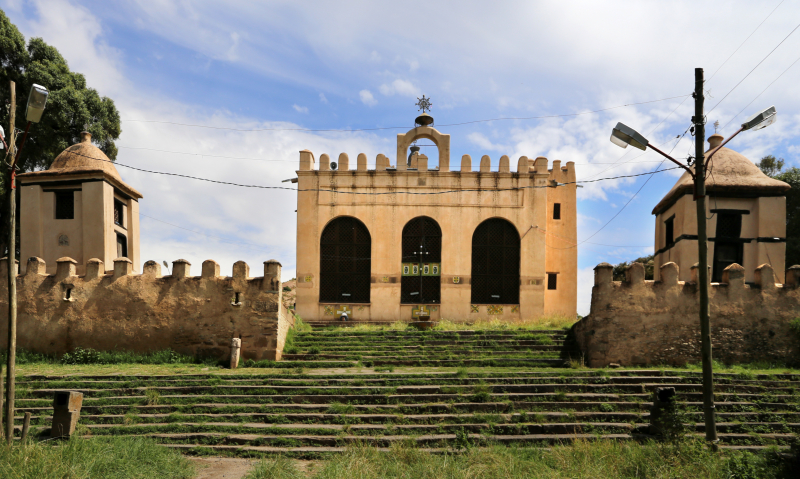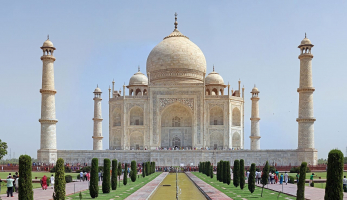Top 8 Oldest Churches in the World
The church plays a very important role in the spiritual life of people. In the past, our ancestors built many churches to express their beliefs and beliefs. ... read more...Let's find out with Toplist the oldest churches in the world!
-
The first position on the list of the oldest churches in the world is the Church of Our Lady Mary of Zion. The Ark of the Covenant is rumored to be present in the Church of Our Lady Mary of Zion, an Ethiopian Orthodox Tewahedo church. The church is situated close to the grounds of the Obelisks of Axum in the northern Ethiopian town of Axum in the Tigray Region. The first church is thought to have been erected in the 4th century AD during the reign of Ezana, the first Christian king of the Kingdom of Axum (current-day Eritrea and Ethiopia), and has subsequently been restored multiple times.
The Church of Mary of Zion has been destroyed and rebuilt at least twice since its founding under the episcopacy of Frumentius (also known in Ethiopia as Abune Selama Kesatie Birhan or "Our Father of Peace the Revealer of Light"). In the 10th century, Queen Gudit allegedly destroyed it for the first time. Its second verified demolition took place in the 16th century at the hands of Ahmad ibn Ibrahim al-Ghazi, after which Emperor Gelawdewos repaired it. Later, in the 17th century, Fasilides further rebuilt and expanded it.
Location: 4PJ9+5RH, Aksum, Ethiopia

Photo: wikipedia 
Photo: travelnetworth.com -
The foundations of one of the earliest churches ever found by archaeologists, Megiddo Church, which is located close to Tel Megiddo in Israel, dated to the 3rd century AD. The remains were discovered close to Megiddo Prison, which is situated in northern Israel just a few hundred meters south of the tell and close to Megiddo Junction. The region belongs to Legio, an ancient Roman settlement that was formerly known by its Hebrew name, Kefar 'Otnay. Megiddo Church is one of the oldest churches in the world.
The remnants of this late third-century church were initially unearthed in 2005 by prisoners of the jail that presently stands where the church once stood. The site was further explored by a Tel Aviv University-affiliated Israeli archaeologist. A number of items were found, including a sizable mosaic with a depiction of a fish (an early Christian emblem) and various Greek inscriptions. One of these inscriptions refers to a woman by the name of Aketous giving the church a table, probably for use as an altar.
Location: near Tel Megiddo, Israel
Photo: historyhit.com 
Photo: twitter -
One of the most significant Christian sites in the world is St. Peter's Basilica in Vatican City, which is a church with a distinguished history as opposed to a cathedral. St. Peter's Basilica, also known as the "Papal Basilica of Saint Peter" and known in Italian as "Basilica Papale di San Pietro in Vaticano," is located over the location of its namesake's grave. In the year 324 AD, Constantine, the Roman emperor, erected the first basilica above the Circus of Nero. The saint's shrine is still present in St. Peter's Basilica, and it is believed that he is interred under the papal altar.
Visitors can examine a variety of historical artwork, primarily from the Renaissance, as well as the tombs of former popes such Pope Pius XI (1939), Pope John XXIII (1963), and Pope John Paul II inside St. Peter's Basilica (d. 2005). The Basilica's Grottoes are home to many of their tombs.
The Pieta by Michelangelo, the foot of which pilgrims typically touch, the Statue of St. Peter Enthroned by Arnolfo di Cambio, and the gilded Monument to Pope Alexander VII by Bernini are just a few of St. Peter's Basilica's most notable works of art. The Historic Center of Rome is a UNESCO World Heritage site, and St. Peter's Basilica is a component of that.
Location: Piazza San Pietro, 00120 Città del Vaticano, Vatican
Photo: wikipedia 
Photo: ciaoflorence.it -
At least 270 AD marks the beginning of the Christian era at the location of Trier Cathedral, when worshipers congregated in what was likely the first church to have ever stood there—a house church. You can visit this UNESCO World Heritage Site today, a historical monument.
The continuing persecution of Christians started to lessen in the fourth century. The ability to worship more publicly was made possible by the expansion of religious freedom. Thus, starting in 340 AD, a structure known as "The Square" was built on the site of Trier Cathedral. The exterior walls of this building, which are now a part of Trier Cathedral, are some of the remnants still visible today.
The church itself contains few traces of the ancient Ancient Roman church today, although vast underground excavations can be seen as part of a guided tour (book in advance on the official site).
Along with these subterranean remnants, the main building still contains a portion of the old Roman walls, which rise to a height of over 30 meters. The remainder of Trier Cathedral, which looks more like a fortification than a place of worship and contains a few more obvious Roman components and columns, beautifully retains the medieval heritage of this location.
Location: Trier, Rhineland-Palatinate, Germany

Photo: trior-infor.de 
Photo: trekearth.com -
Pantheon is one of the oldest churches in the world is Pantheon in Rome. The Pantheon was initially constructed by Marcus Agrippa in 25 BC as a temple for the numerous Roman deities. The current Pantheon was built after Hadrian's reign, approximately 125 AD, when the ancient Pantheon, which still bears Agrippa's original inscription, was completely burned in the great fire of 80 AD.
The Pantheon, one of the most famous and magnificent structures of the ancient world, is open for free tours today; on Saturday evenings and Sunday mornings, it is closed for Mass. To truly immerse yourself in the history of the location, it is worthwhile to pay a modest fee to hire an audio guide. Since it has been a church dedicated to St. Mary and the Martyrs but is more often known as "Santa Maria Rotonda" since the 7th century, it is one of the best-preserved of all Ancient Roman structures. Piazza Della Rotonda is the name of the public space in front of the Pantheon. The Pantheon is a public building that is overseen by the Polo Museale del Lazio, a division of Italy's Ministry of Cultural Heritage and Activities and Tourism. It received almost 6 million visitors in 2013.
Even now, entering the Pantheon still causes people to grasp: It is still the largest unreinforced concrete dome ever constructed, standing at 2,000 years old. The shaft of light that floods in to illuminate the tombs below seems almost supernatural in nature.
Location: Rome, Lazio, Italy
Photo: hanoimoi.com.vn 
Photo: wikipedia.org -
The next position on the list of the oldest churches in the world is Aqaba Church. The third-century Aqaba Church is a revered historical building in Aqaba, Jordan. It is regarded as the oldest surviving purpose-built Christian church in the world and was discovered in 1998 by a team of archaeologists. Its initial construction was completed between 293 and 303, making it older than both the Church of the Nativity in Bethlehem and the Church of the Holy Sepulchre in Jerusalem, both of which were constructed in the late 320s.
It is believed that its remote location inside the Roman Empire prevented it from being destroyed during the Great Persecution, which broke out only a few years after the church was built. The structure was shaped like a sizable basilica with three aisles, a narthex, and an east-west axis. It had mud-brick on stone foundations, 85 feet (26 m) by 53 feet (16 m) in size, and had arched doors and what appeared to be a vaulted nave and aisles. It may have had a second story, based on the remains of a staircase. A rectangular apse followed a chancel area that marked the conclusion of the nave.
The foundations of a chancel screen, a collection box filled with cash, pieces of glass-made oil lamps, walls up to 4.5 meters (15 feet) high, a cemetery with 24 bones right next to the church, and more were all uncovered by archaeologists.Location: Aqaba, Jordan
Video: https://www.youtube.com/watch?v=msjB8WqwE3M 
Photo: wikipedia -
A number of different civilizations inhabited the prosperous ancient city of Dura Europos in eastern Syria. Currently, just a few well-maintained ruins are visible. Dura Europos was established around 300 BC by the Seleucid Greeks, one of the successor republics that developed after the death of Alexander the Great. They chose to site it in the middle of their two major cities and with a view of the Euphrates River.
The majestic ruins of Dura Europos serve as a reminder of its rich cultural and historical diversity today. The location is home to the remains of the world's oldest synagogue and what has been called the first church, in addition to Greco-Roman ruins comprising temples. Visitors can tour the massive defenses, including walls and fortifications, as well as the remains of the siege operations that destroyed the city. The steep cliffs above the Euphrates offer stunning vistas as well.
It is not advised for visitors to travel to Syria at this time due to the country's political climate. However, there are some knowledgeable tour operators, like Nawafir Travel & Tours, that can show you around the site while an expert is in the driver's seat.
Location: Qusur Umm Saba, Deir ez-Zor, Syria
Photo: wikipedia 
Photo: wikipedia -
One of the oldest churches in the world is San Miguel Chapel. It's thought that Tlaxcalan communities that migrated to New Mexico from the Mexican state of Tlaxcala constructed it between 1610 and 1626. Initially, it was believed that Tlaxcalan laborers and newly arrived Spanish soldiers from Mexico used the church.
The chapel is situated in Santa Fe's Barrio de Analco, a district designated as a national historic site. According to oral history, a group of Mexican Indians from Tlaxcala created the neighborhood. The Franciscan friars oversaw the construction of the modest adobe church to serve the residents of the Barrio de Analco, which included soldiers, laborers, and Indians. During the Pueblo Revolt of 1680, it was partially destroyed. The current structure was constructed around 1710, however there have been substantial structural alterations since then.
The church suffered severe damage on numerous occasions, but it was always repaired and rebuilt (once as a result of a dispute between the governor of New Mexico and church authorities, and again during the Pueblo Revolt, when the Pueblo people ousted Spanish colonizers). A violent storm in 1872 demolished a three-story bell tower that had been constructed in 1848, but the "San Jose Bell" was spared and is now on display inside the church.
Location: 401 Old Santa Fe Trail, Santa Fe, NM 87501, America

Photo: tripadvisor.co.uk 
Photo: santafeselection.com





























